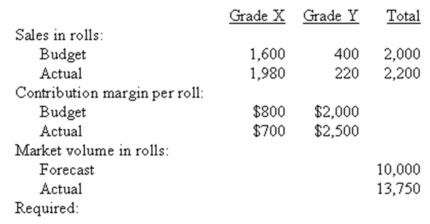(Appendix 10C)Iraj Company retails two grades of Persian carpets: Grade X and Grade Y.The carpets are sold by rolls.The following is a summary of the company's activities for last year: 
Required:
a)Assume the two grades of carpet are close substitutes.Calculate the sales volume variance for each grade of carpet and analyze each into a sales mix variance and a sales quantity variance.
b)Analyze the sum of the sales quantity variance into its two components: market volume variance and market share variance.
c)Comment on the appropriateness of the assumption of close substitution between the two grades of carpet.Comment also on the effect,if any,on the analysis in part a)above if this assumption is considered inappropriate.
Definitions:
Production Possibilities
A curve depicting all maximum output possibilities for two goods, given a set of inputs consisting of resources and other factors.
Opportunity Cost
Forgoing possible gains from alternative paths when one path is chosen.
Farmer
An individual engaged in agriculture, raising living organisms for food or raw materials.
Comparative Advantage
The ability of a party to produce a particular good or service at a lower marginal and opportunity cost than another.
Q9: Onyx Company prepared a static budget at
Q25: (Appendix 12A)The markup on absorption cost for
Q26: The Frito-Lay division of PepsiCo is most
Q65: When a company is preparing a budgeted
Q65: What was the fixed overhead volume variance
Q68: What would the annual cost of additional
Q74: If upper management is NOT satisfied with
Q127: A favorable variance reflects an increase in
Q166: The following labour standards have been established
Q204: Which of the following variances would be